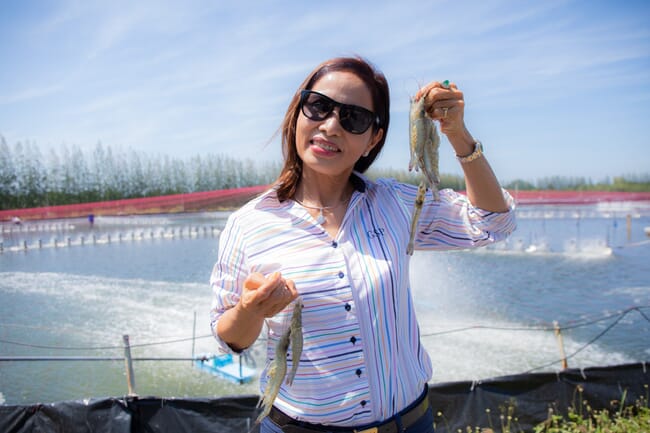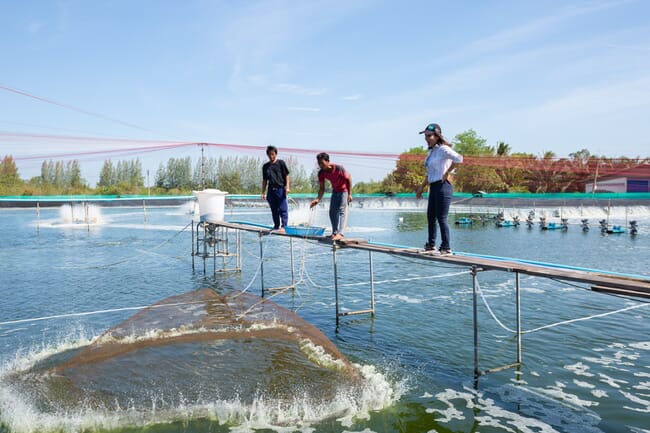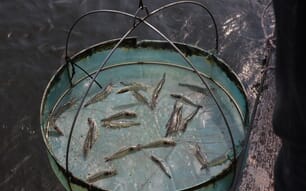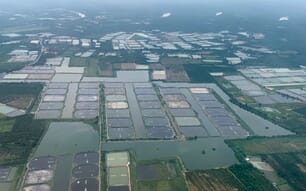What inspired you to start producing shrimp?
Before starting my own shrimp business I worked at the government’s revenue department. One day, while on the bus to work, I heard people talking about how successful a shrimp farmer was in Kanchanadit District. After a good harvest this farmer had made 400,000 baht (£10,290) profit per pond, which, at that time, was very high impressive. This made me want to try growing shrimp and I started by renting a small, six pond farm with help of a bank loan. After a successful harvest I was able to use the profit to open a store distributing aquaculture-related products.

© Quality Farms
Three years later I resigned from my government job in order to focus full time on the shrimp industry, as an aquaculture product distributor and shrimp farmer and I’m now producing about 280-330 tonnes of shrimp per year.
What have been your hardest challenges to overcome so far?
Shrimp farming is a never-ending learning path. Challenges such as disease and shrimp prices are a farmer’s daily concern and evolve and change frequently. This makes us need to constantly monitor and analyse situations, think about solutions and quickly adapt to these evolving challenges.
Compared to when I first started, shrimp farming is getting more and more difficult, due to the increased frequency of new diseases and combination of diseases, such as, AHPND (acute hepatopancreatic necrotic disease), EHP (Enterocytozoon hepatopanei), white faeces syndrome and SHIV, as well as challenges related to environmental pollution.
What has been your proudest moment as a shrimp producer to date?
My proudest moment was when I produced 330 tonnes of premium quality shrimp in a single year. These shrimp were large, attractively coloured and met both GAP2011 and BAP 2019 production standards. I’m proud that our shrimp are attracting buyers from the European market.
How important are diets in ensuring the consistency and quality of shrimp production?
The quality of the feed is extremely important and many factors affect the quality – the size of the feed particles, palatability and smell, stability in the water, the protein content and nutritional profiles. If the feed is correct it helps us reduce the FCR and thus maximise profitability and the consistency of a diet is vital too.
Good feed also helps keep our workers motivated, as they recognise particular brands for quality that brings them success in production. At the end of a production cycle it is the workers who request to use a particular brand for the next crop.
Why did you decide to start using INVE’s advanced nutrition products?
First of all, INVE is a trustworthy company and known to be reliable. Since starting to work with them I’ve been producing shrimp successfully, and their products have helped me to prevent and solve the main production challenges, such as white faeces syndrome, EMS, environmental pollution and vibriosis. Being a distributor of aquaculture products, I’ve wanted to share my experience and recommend and encourage my customers to use INVE products in order to be as successful as me.
Which ones do you use and why?
In terms of feeds I use the S-Pak range as well as Frippak Raceway, as I don’t have a nursey at my farm but stock the post-larvae directly from the hatchery to the grow-out farm. This means the shrimp are small when first stocked into the grow-out ponds and would otherwise struggle to find feed due the strength of the currents from the paddle wheels as well as the size of my ponds. The S-Pak range is therefore very important at the early stages, as its high quality protein content makes it very enticing as well as giving it good water stability. This product is very complete in terms of nutritional value but will also boost their health since it contains immune-enhancer (not provided in regular starter diets).
Frippak Raceway has very suitable pellet sizes for the early stages of shrimp culture. It has the most complete nutritional profile for good shrimp growth, particularly at the early stages when the growth rate is the highest.

© Quality Farms
How do you help to ensure the health of your shrimp and maintain suitable water quality in the pond?
Firstly analysis is done, based on visual observation compared to optimum health standards and experience in shrimp production. This analysis is done on the feed tray, by observing shrimp behaviour, their colour, the content of the gut, their shape, the faeces and the leftover feed in the tray.
Additionally, we sample the water and the shrimp once or twice a week and these samples are then analysed in a lab. These tests will help to check the water quality as well as the shrimps’ biological condition and we screen for pathogens (such as bacteria, viruses and microsporidia), conduct intestinal checks and histopathology and check the water chemistry.
Once we have the analysis reports from both the lab and our on-site visual observations, we will take actions accordingly and fine-tune our production protocols if necessary.
For example, if we see a rise in vibriosis count in the environment over time, we will use INVE’s Sanocare PUR to disinfect the water, in order to reduce the concentration of vibriosis in the environment. Six hours later we will apply Sanolife Pro W, INVE’s Bacillus-based probiotic, to populate the pond with beneficial bacteria in order to limit the growth of harmful bacteria.
How do you choose which products to use in each pond?
There are countless health products in the market, for a wide range of prices and I choose them based on their value and returns. Some might appear expensive but are actually helping improve farm condition, performance and profitability.
Another important point is their ease of use. For instance, Sanolife Pro W environmental probiotics are highly concentrated (5x10e10 CFU/g) and do not require fermentation. As the product can be directly applied to the water there’s no risk of cross-contamination, unlike those that require fermentation. When applying it in the pond we are sure about what is going into the environment and get the results expected: control of harmful bacteria, a reduction of pH fluctuations and the creation of an optimum environment for the shrimp throughout the culture period.
How has optimising your feed and health strategies affected to performance of your shrimp ponds?
Optimising our feed management and health protocols have helped us achieve a consistent and sustainable level of production, which helps us manage our cash flow. It has also reduced the risks of challenges such as disease outbreaks and our shrimp have now a consistent growth rate.
In our farm area in Surat Thani, for example, white spot disease (WSSV) outbreaks are very common, but our farm has managed to avoid infections from WSSV thanks using smart disinfectants and probiotics to increase biosecurity. Besides WSSV, white faeces syndrome (WFS) has been adversely affecting the zoo-technical performance of the farms in the area for about two years. We have also seen this syndrome but only 10-15 percent of our shrimp are affected and we still can control production until the shrimp reach our target harvest size, which tends to be between 15-25g, depending on market demand. Other farms in the area have had to harvest prematurely when hit by WFS.
How would you like to see your own farm develop?
Shrimp farming relies on the surrounding environment. Using products that are not environmentally friendly and safe can reduce the sustainability of the whole shrimp industry. Our farm will therefore develop in an environmental friendly way to ensure the sustainability of the industry.
Our farm only uses registered products and that are safe for the environment and our production methods have to be sustainable – for example, minimising the release of waste water and treating it before release. Safety for the workers must also be considered.
How do you think INVE can help you achieve your goals?
By continuing to supply top quality products following good standard manufacturing processes. Continuous development of such products and services to answer farmers’ needs in a sustainable way will definitely help our shrimp business too.
How do you see the shrimp sector as a whole developing over the next decade?
Shrimp farming will become more difficult every year. Problems and challenges such as diseases, shrimp prices and regulations will affect production. Added to that, global competition is getting tougher, which also has an impact on the business.
The environment is deteriorating and water and soil are getting more and more polluted. Shrimp farming must therefore constantly evolve and new farming and production methods (such as indoor farms, nurseries and zero-water exchange systems) should be studied and evaluated to overcome future challenges.
Another key factor for the successful future of the shrimp industry is the ongoing genetics work: improvements in disease resistance, growth rates and the adaptability of shrimp to changing environmental parameters will be another factor needed for the sustainable development of our industry.
This interview was originally published in Technologies shaping the future of shrimp production, the first issue in Benchmark's insights series. To access the issue in full visit Benchmark’s website.








